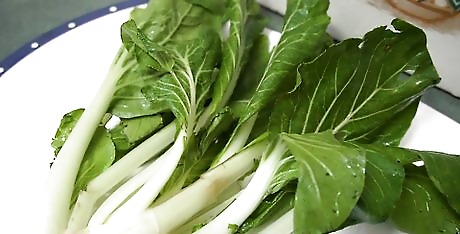
views
Choosing and Washing Your Bok Choy

Choose bok choy with bright green leaves and crisp stalks. Look for heads with bright green leaves — not yellow or brown — and crisp white stalks without holes or discoloration. Avoid any bok choy bunches that look rubbery or dried out towards the stem. Crunchy is good! Bok choy, also known as pak choi, can be found in a number of varieties that offer different flavors, sizes and colors. Varieties with larger leaves tend to work well for salads and soups, while the smaller, narrower heads work well for stir-fries.

Buy baby bok choy for a milder flavor. Baby bok choy is a smaller variety of bok choy that is just harvested earlier than mature bok choy. The stems are usually thicker and the leaves are smaller. The flavor is usually pretty similar to regular bok choy, but it often milder and more tender. Baby bok choy is also appealing because you can cook the vegetable whole without needing to break the leaves apart.

Store your bok choy in a plastic bag in the fridge for up to 5 days. Place your bok choy in a grocery store plastic produce bag. With the bok choy in the bag, run your hand along the stalk to push the air out of the bag. Twist the end of the bag so it stays shut and store it in your produce drawer in your refrigerator for up to 5 days.

Trim and discard the thick base of the bok choy stem. Use a sharp knife to slice off the bottom ⁄2 to 1 inch (1.3 to 2.5 cm) just above where the base of the leaves connect. Pull off and discard any outside leaves that are discolored or particularly tough. You will be left with several long individual bok choy stalks.

Wash the individual bok choy stalks in a bowl of cold water. Separate the leaves and swish them around in large bowl full of cold water. Gently rub the leaves together to remove any dirt. Drain the water from the bok choy using a colander. Alternatively, you can rinse each individual stalk under cold running water in your sink. Dirt tends to collect towards the base of each stalk, so pay special attention to that part.
Slicing the Bok Choy

Bunch the stalks together and slice off the white stems. Once all the stalks have been washed, lie them flat on your cutting board. Then, group them together in a bunch and use your knife to separate the thick, white stems from the green leaves. Keeping the stems and leaves separate is helpful because the stems and the leaves tend to cook at different rates, with the stems cooking slower than the leaves.

Hold the bok choy in a stable position using a claw-like grip. Grip the bok choy with your fingertips and curl them inwards, pressing only the knuckles of your middle and ring fingers against the knife blade. This grip will protect your fingers.

Hold your knife at a 45 degree angle over the bok choy stems. Don’t chop the stems by bringing the knife straight down — hold it at a 45 degree angle for a slanted cut across the stem. Slicing at an angle like this works to increase the surface area of each piece, allowing the bok choy to cook faster.

Slice the bok choy into 1 in (2.5 cm) sections. Cut the stems into 1 in (2.5 cm) sections beginning at the base and slicing all the way up to the top. Gradually move the hand that holds the bok choy away from the knife as you slice further along the stalk. Then, repeat this process for the leaves. Make your cuts thinner if you’re looking to make a stir fry.
Cutting the Bok Choy Into Rectangles

Cut an individual stalk in half down the middle. Make a long cut down the middle of an individual white stalk to separate it into 2 halves. Lay these halves next to each other flat on your cutting board. If you want thinner rectangle slices, cut your bok choy stalk into thirds. Rectangle cuts can be great if you’re looking to saute bok choy stems with other vegetables or meats.

Separate the green leaves from the white stem. Slice off the leafy part of the bok choy, leaving mostly thick, white stem. It’s fine if you leave some of the smaller leaf sections where the leaves connect to the stem, but try to remove as much of the leaves as you can.

Cut the stem into 1 in (2.5 cm) long rectangular pieces. Make horizontal cuts to divide the stem up into bits that are roughly the shape of rectangles. These pieces should be pretty thick.
Dicing the Bok Choy

Cut the leaves off of the bok choy. Take an individual stalk of bok choy and cut off the top leafy part. You should be left with the remaining white stem. Diced bok choy is a wonderful addition to soups and salads!

Slice the stem vertically into 3 long strips. Use a larger knife to make these longer cuts in 1 smooth motion each. Try to make all the strips about the same width.

Cut the strips horizontally into small ⁄2 in (1.3 cm) long diced pieces. Bunch the strips together with your non-dominant hand, and carefully dice them into small pieces starting at the end of the stem. ⁄2 in (1.3 cm) long is good, but make the pieces smaller if you want.




















Comments
0 comment